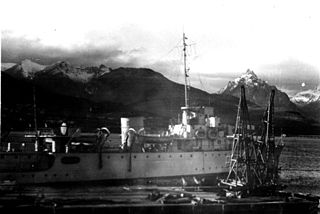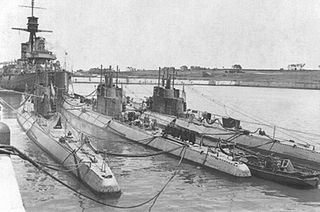Basilio Villarino was a captain of the Spanish Royal Navy who traveled around the southern tip of South America. In 1837 some of his writings were published as Diario de la Navegación Emprendida en 1781, Desde el Rio Negro, para Reconocer la Bahia de Todos los Santos, las Islas del Buen Suceso, y el Desague del Rio Colorado.

ARA Buenos Aires was the lead ship of her class of destroyer built for the Argentine Navy, in service from 1938 to 1971.

ARA King is a World War II-era Argentine Navy warship, originally classified as minelayer and later as patrol ship. The vessel is named after Juan King, an Argentine naval officer that served in the Cisplatine War. It is the third Argentine naval ship with this name.

ARA La Argentina was a steam corvette that served as a training ship with the Argentine Navy between 1884 and 1895, and in other roles until decommissioned in 1899.

ARA Azopardo is a World War II era Argentine Navy warship, originally classified as patrol boat and later as antisubmarine frigate. The vessel is named after Juan Bautista Azopardo, an Argentine naval officer that served in both the Argentine War of Independence and in the Cisplatine War. It is the third Argentine naval ship with this name.

ARA Piedra Buena is a World War II era Argentine Navy warship, originally classified as patrol boat and later as antisubmarine frigate. The vessel is named after Luis Piedrabuena, an Argentine mariner that explored and guarded Argentine sovereignty in Patagonia. It is the third Argentine naval ship with this name.
ARA Petrel was a hydrographic survey boat of the Argentine Navy, built in the Cadenazzi Shipyard and based in Buenos Aires. The vessel is named after the petrel, a seabird that inhabits Argentina's littoral, and is the third Argentine naval ship with this name.
ARA Azopardo was a tugboat of the Argentine Navy, built in the Bethlehem Shipyard in 1919 and transferred to Argentina in 1922. It was based at the port of Buenos Aires and later at Puerto Belgrano, and was decommissioned in 1941. The vessel was named after the Juan Bautista Azopardo, a Maltese privateer and officer of the Argentine Navy during the Independence and Cisplatine wars, and was the second Argentine naval ship with this name.
ARA Azopardo was a steam transport of the Argentine Navy, built in the Stabilimento Tecnico Triestino and sold to Argentina in 1884. It was based, among others, in the port of Buenos Aires and later Ushuaia, and was decommissioned in 1922 after being sunk in an accident; it was refloated and sunk in 1924 as a target. The vessel was named after the Juan Bautista Azopardo, a Maltese privateer and officer of the Argentine Navy during the Independence and Cisplatine wars, and was the first Argentine naval ship with this name.

PNA Azopardo (GC-25) is a Mantilla-class patrol boat of the Argentine Naval Prefecture, built at the Empresa Nacional Bazán shipyards and commissioned in 1983. The vessel is named after Juan Bautista Azopardo, a Maltese privateer and officer of the Argentine Navy during the Independence and Cisplatine wars, and Harbourmaster of Buenos Aires; she is the second PNA ship with this name.
PNA Prefecto Derbes (GC-28) is a Mantilla-class patrol boat in service with the Argentine Naval Prefecture, built at the Empresa Nacional Bazán shipyards and commissioned in 1984. The vessel is named after Pedro Derbes, a former commander of the “Prefectura de Puerto Madryn” of the PNA; she is the first ship of this service with this name.

The Murature-class patrol ships are a class of World War II era Argentine Navy warships, originally classified as minelayers and later reclassified as patrol ships. The class is named after José Luis Murature, Foreign Minister of Argentina from 1916 to 1918.

The Rosario-class gunboats were a class of two pre-World War I warships, designed and built in England in 1907–1909 as armoured riverine gunboats, to patrol the rivers Paraná and Uruguay. They were in service with the Argentine Navy from the late 1900s to the early 1950s. The lead ship of the class was named after Rosario, one of the major cities in Argentina.

The Santa Fe-class submarines, also known as the Tarantinos after the city in which they were built, were a class of three pre-World War II submarines, designed and built in Italy in 1928-1933, as part of an Argentine expansion plan for its navy. They were in service with the Argentine Navy from the early 1930s to the late 1950s. The class was named after Argentine provinces starting with “S”, as traditional in the Argentine Navy.

ARA Cabo de Hornos (B-5) was a cargo ship in service with the Argentine Navy since 1979, capable of transporting bulk cargo, live cattle, and containers. She was the second ship in the Argentine Navy to bear the name of the Cape Horn (Chile) located to the south of Tierra del Fuego.

ARA Canal Beagle (B-3) is a cargo ship in service with the Argentine Navy since 1978, capable of transporting bulk cargo, live cattle, and containers. She is the second ship in the Argentine Navy to bear the name of the Beagle Channel in the south of Tierra del Fuego.

The Costa Sur-class cargo ship is a class of three cargo ships designed and built in Argentina in 1975–1979 for servicing the Patagonic coast routes; capable of transporting bulk cargo, live cattle, and containers. The ships have been in service with the Argentine Navy since 1978. The class is named after the southern coastal area of Argentina which was designed to service.













